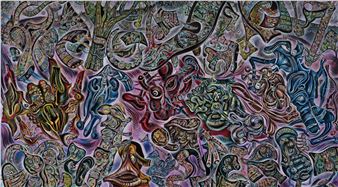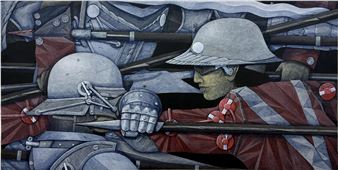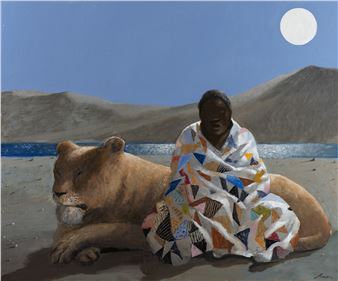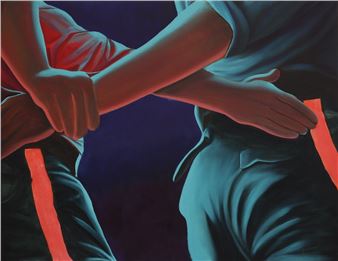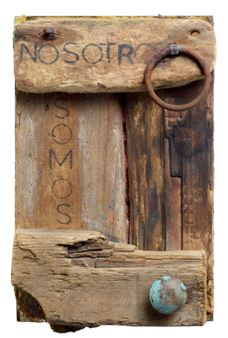Antonio SeguĂ: A Retrospective Exhibition 1966-2010
Antonio SeguĂs fascination with the city, its people and its movement has been a part of his work for the past three decades. The artist, in a pre-computer age, has created a vocabulary now being explored by a new generation of artists through comics and Manga.
Often described as the painter of cities, Segui pulls inspiration from the modern-day man - urban, fast-paced and intense. Noticeably repeated throughout many of Seguis compositions is the automaton, his version of the “everyman”, the faceless passerby and the anonymous being that serves as a fleeting thought. Up close the figure is an individual, walking down dark alleys, pointing, waving, and emerging from potholes. But at a distance, the individual morphs into a complex pattern swallowed up in a labyrinth of buildings and cookie-cutter trees. Seguis perfectly duplicated images mimic those that are computer generated, but ironically, he adopted this style well before computer technology became mainstream.
Seguis visual language and social commentaries are more poignant today, both symbolically and literally, than when they first started appearing in his work. He often explores mans place in society with scribbled words referencing current events that act as a ground for the “everyman” to tread upon. In his most recent series, he targets the operator of the largest Ponzi scheme in history, Bernie Madoff. The paintings clearly reflect the tragedy, anger and confusion of society with broken phrases packed between buildings and symbols of money plastered on every briefcase.
Utilizing cubist techniques, Seguis repeated elements give shape to the cities causing planes to vibrate between line and color. Numerous perspectives unfold with each vibration and reflect the many angles of life of the urban man. Always in action, the little figures trample, tip-toe, dodge and advance through Seguis imaginary metropolis of life.
Antonio SeguĂ began his artistic endeavors at a young age when he left Argentina to travel the world and study art. Places like Latin America, Europe and Africa exposed him to new ideas and encouraged his culturally diverse approach to art. Influenced by artists like Fernand Leger and Diego Rivera, Seguis work is generally satirical, critiquing society and human nature.
Born in Córdoba, Argentina in 1934, Antonio Seguà currently lives and works in Paris. He studied at the San Fernando Academy in Madrid, Spain as well as the Ecole des Beaux-Arts in Paris, France. His first solo exhibition was in Argentina at age 23. Seguis work is collected and exhibited worldwide in places such as the MoMA, New York; Art Museum of the Americas, Washington, DC; Frissiras Museum, Athens, Greece; Museo de Arte Moderno de Buenos Aires, Buenos Aires, Argentina; Museum der Moderne Salzburg, Salzburg, Austria; Museum of Modern Art Dubrovnik, Dubrovnik, Croatia; and Museo Tamayo, Mexico City, Mexico. The Musée National d´Art Moderne, Paris organized a retrospective of his works on paper in 2005. A monography of his work was written by Daniel Abadie in 2010.

Recommended for you
Antonio SeguĂs fascination with the city, its people and its movement has been a part of his work for the past three decades. The artist, in a pre-computer age, has created a vocabulary now being explored by a new generation of artists through comics and Manga.
Often described as the painter of cities, Segui pulls inspiration from the modern-day man - urban, fast-paced and intense. Noticeably repeated throughout many of Seguis compositions is the automaton, his version of the “everyman”, the faceless passerby and the anonymous being that serves as a fleeting thought. Up close the figure is an individual, walking down dark alleys, pointing, waving, and emerging from potholes. But at a distance, the individual morphs into a complex pattern swallowed up in a labyrinth of buildings and cookie-cutter trees. Seguis perfectly duplicated images mimic those that are computer generated, but ironically, he adopted this style well before computer technology became mainstream.
Seguis visual language and social commentaries are more poignant today, both symbolically and literally, than when they first started appearing in his work. He often explores mans place in society with scribbled words referencing current events that act as a ground for the “everyman” to tread upon. In his most recent series, he targets the operator of the largest Ponzi scheme in history, Bernie Madoff. The paintings clearly reflect the tragedy, anger and confusion of society with broken phrases packed between buildings and symbols of money plastered on every briefcase.
Utilizing cubist techniques, Seguis repeated elements give shape to the cities causing planes to vibrate between line and color. Numerous perspectives unfold with each vibration and reflect the many angles of life of the urban man. Always in action, the little figures trample, tip-toe, dodge and advance through Seguis imaginary metropolis of life.
Antonio SeguĂ began his artistic endeavors at a young age when he left Argentina to travel the world and study art. Places like Latin America, Europe and Africa exposed him to new ideas and encouraged his culturally diverse approach to art. Influenced by artists like Fernand Leger and Diego Rivera, Seguis work is generally satirical, critiquing society and human nature.
Born in Córdoba, Argentina in 1934, Antonio Seguà currently lives and works in Paris. He studied at the San Fernando Academy in Madrid, Spain as well as the Ecole des Beaux-Arts in Paris, France. His first solo exhibition was in Argentina at age 23. Seguis work is collected and exhibited worldwide in places such as the MoMA, New York; Art Museum of the Americas, Washington, DC; Frissiras Museum, Athens, Greece; Museo de Arte Moderno de Buenos Aires, Buenos Aires, Argentina; Museum der Moderne Salzburg, Salzburg, Austria; Museum of Modern Art Dubrovnik, Dubrovnik, Croatia; and Museo Tamayo, Mexico City, Mexico. The Musée National d´Art Moderne, Paris organized a retrospective of his works on paper in 2005. A monography of his work was written by Daniel Abadie in 2010.

 ARTISTS
ARTISTS







